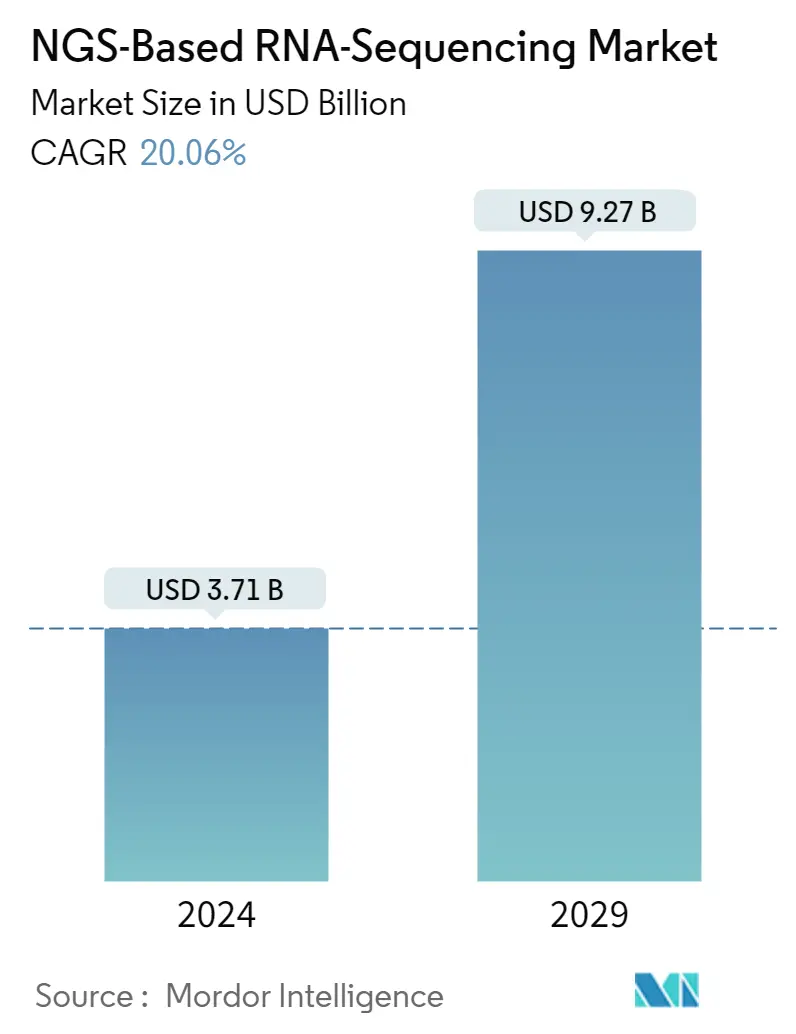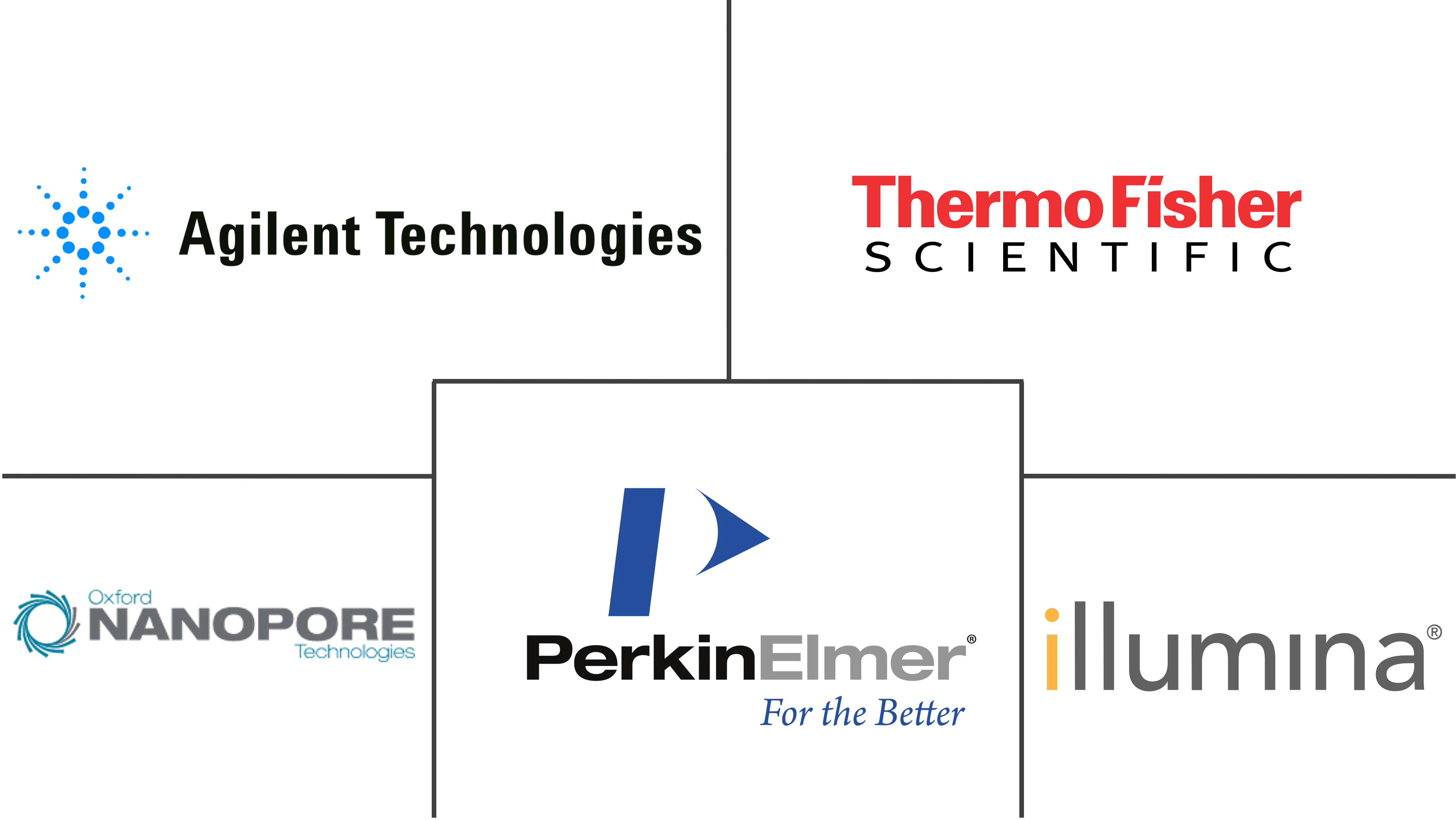Market Size of NGS-Based RNA-Sequencing Industry

| Study Period | 2019 - 2029 |
| Market Size (2024) | USD 3.71 Billion |
| Market Size (2029) | USD 9.27 Billion |
| CAGR (2024 - 2029) | 20.06 % |
| Fastest Growing Market | Asia-Pacific |
| Largest Market | North America |
Major Players
*Disclaimer: Major Players sorted in no particular order |
Need a report that reflects how COVID-19 has impacted this market and its growth?
NGS-based RNA-Sequencing Market Analysis
The NGS-Based RNA-Sequencing Market size is estimated at USD 3.71 billion in 2024, and is expected to reach USD 9.27 billion by 2029, growing at a CAGR of 20.06% during the forecast period (2024-2029).
The COVID-19 pandemic had an effect on the growth of the NGS-based RNA sequencing market, as next-generation sequencing has become the research tool of choice for many scientists trying to stop the COVID-19 pandemic.For example, an article in Frontiers in Cellular and Infection Microbiology from March 2021 says that researchers have used next-generation sequencing (NGS) to look at hundreds of coronavirus genomes and the SARS-CoV-2 genome.But because of their many benefits, NGS and RNA sequencing have made more technological progress, which has pushed companies and researchers to use them more.For example, in February 2022, a group of researchers from different institutions led by professors at IIT Jodhpur came up with a way to use artificial intelligence (AI) and genome sequencing to recognize COVID-19 virus RNA variations.So, the studied market is likely to grow because NGS platforms are being used more and more in research and development around the world.
Market growth is being driven by things like the rise in the number of products approved for RNA sequencing platforms and consumables, progress in precision medicine, and the benefits of NGS-based RNA sequencing.
The growing number of product approvals and launches of RNA-sequencing platforms and consumables is anticipated to drive the growth of the market over the forecast period. For instance, in October 2021, Takara Bio USA, Inc. launched the SMART-Seq Pro kit for the ICELL8 cx Single-Cell System, an automated single-cell RNA-seq solution that allows scientists to generate full-length transcriptome data from over 1,500 single cells simultaneously and from a wide range of sample types. Also in September 2021, Alithea Genomics released its first MERCURIUS BRB-seq kits. These kits allow RNA-seq library preparation from a variety of RNA sources with high throughput and low cost.
The fast emergence of next-generation sequencing technology has revolutionized the field of genomics and medical diagnosis and changed the traditional model of a gene-by-gene approach to a syndrome-based panel sequencing, diagnostic exome sequencing (DES), and diagnostic genome sequencing (DGS) precision model.
Additionally, the advancement of precision medicine has provided specific strategies for targeted therapies and medicines for patients with cancer and Mendelian diseases that prove to be better than traditional clinical practices. This is anticipated to fuel the demand for NGS-based sequencing, hence propelling the market's growth. For instance, according to the data published by the CDC, it is projected that by May 2021, more than 60 million people will have their genomes sequenced worldwide by 2025, as countries have taken the initiative to sequence large populations.
Furthermore, NGS-based RNA sequencing has several advantages over traditional methods for transcriptome analysis with cost-effective procedures, such as direct quantification and identification of transcripts, covering an extremely broad dynamic range, providing sensitive and accurate measurement of gene expression, generating both qualitative and quantitative data, and revealing the full transcriptome. Additionally, NGS-based RNA sequencing eliminates cross-hybridization and suboptimal hybridization seen in microarrays. Thus, such advantages are expected to increase their adoption over other conventional methods, which in turn is anticipated to fuel market growth over the forecast period.
Therefore, owing to the factors such as increasing product approvals, advantages of NGS-based RNA sequencing, and growing focus on precision medicine, the studied market is expected to grow over the forecast period. However, the lack of standardization and interpretation of complex data and the lack of skilled professionals are likely to impede the growth of the NGS-based RNA sequencing market over the forecast period.
